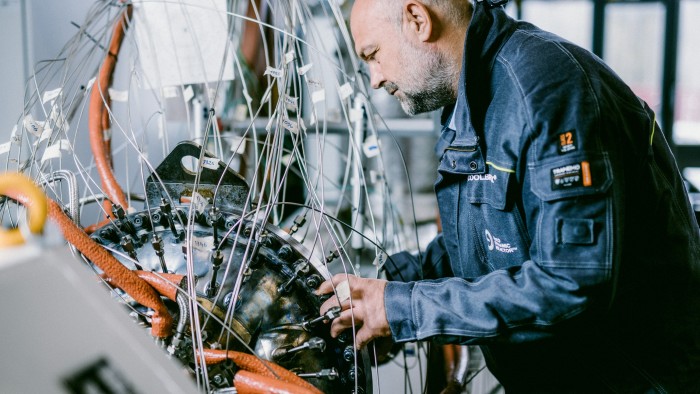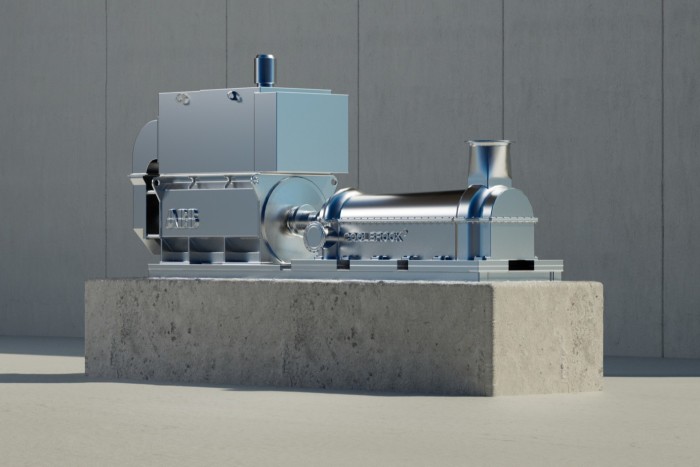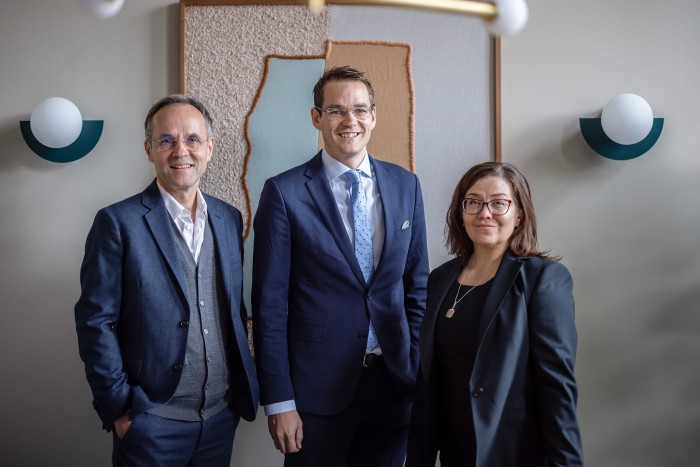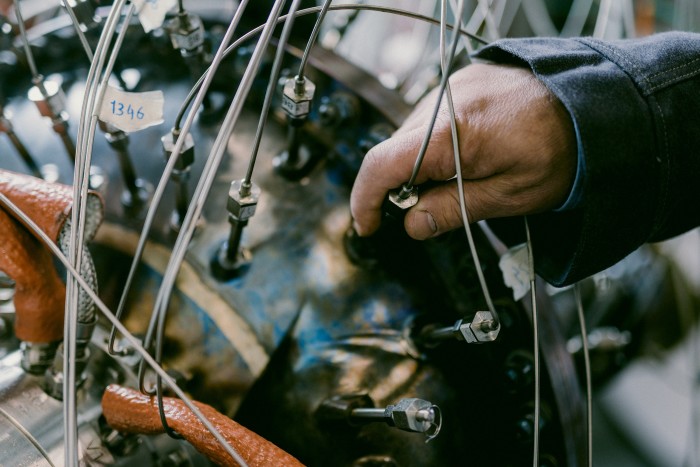Coolbrook heats metal to 1,700°C — while it also tackles global warming

Simply sign up to the Industrials myFT Digest -- delivered directly to your inbox.
It is hard to imagine modern life without the iron, steel, cement, chemicals and everyday plastics produced by heavy industries. According to World Steel Association estimates, the iron and steel sector accounts for between 7 and 9 per cent of man-made CO₂ emissions globally. A further 8 per cent comes from cement making, and the chemicals sector is the third-largest for direct carbon emissions, the International Energy Agency has found.
Despite commitments from all these energy-intensive sectors to reduce their emissions, none is on track to reach net zero by 2050, says the IEA.
But Coolbrook, an engineering technology company based in Finland, is aiming to change all that. It is working on technology that can produce the extreme heat needed for industrial processes from renewable electricity sources.
Until now, even when green electricity has been available in abundance, limitations on its ability to generate high temperatures have precluded its use in heavy industry, which has had to continue deriving its heat from polluting coal, gas and oil.
Now, though, Joonas Rauramo, chief executive of Coolbrook, believes his company has found a way to achieve temperatures of up to 1,700C for industrial processes through a novel form of electrification. “Our sweet spot is above 500C-600C,” he says.
In essence, Coolbrook’s technology reverses conventional turbine theory. For more than a century, coal and other fossil fuels have been burnt to create the heat and kinetic power used to turn turbine-driven generators and power electricity grids. But the start-up’s rotodynamic heaters and reactors turn that process on its head. They use electricity to rotate turbines, which, by forcing a rapid acceleration and deceleration of air or other gases, create violent levels of kinetic energy. This energy can supply the extreme temperatures required by many heavy industrial processes, which cannot normally be achieved by conventional electrification through resistive heaters, because these struggle to exceed a threshold of 500C.

If the engineering principle Coolbrook is reversing has been around for more than a century, the challenge of putting it into practice is a far more modern one. Rauramo and Ilpo Kuokkanen, founder and executive chair, used lessons from jet engines and space programmes to develop the company’s technology. Reetta Kaila, chief technology officer and former director of sustainable fuels at Finland’s Wärtsilä Energy, describes it as “more than rocket science”.
So far, the number of staff involved in developing the technology has been modest. Coolbrook started the year with a headcount of just seven. That had expanded to 23 by October and is expected to reach 30 by the end of the year.
Among the expanding team are chemical engineers Veli-Matti Purola and Elina Nauha, formerly of Finnish refining group Neste, and Tuomas Ouni and Mikko Vermasvuori, previously with Borealis Polymers, the European chemical group headquartered in Vienna.
To add to the rocket science theme, Coolbrook’s team also includes chief designer Alexander Karpov, previously employed at the Russia’s Baikonur space port, and Vladimir Bushuev, who invented the rotodynamic reactor and worked in the Soviet space programme between the 1960s and 1980s.

To date, Coolbrook has built a limited number of prototypes to demonstrate the efficacy of its technology. It has already signed up a range of blue-chip industrial partners that want to help commercialise it and prove its ability to decarbonise steel, cement and chemical manufacturing. Among them are Swiss-Swedish engineering group ABB, cement makers Cemex and UltraTech, oil and gas group Shell, and steelmaker ArcelorMittal.
However, whether Coolbrook can go from one working pilot plant in the Netherlands to worldwide adoption of its decarbonising technology is a moot point. Other approaches are also being sought to meet the challenge. Fellow Finnish innovator VTT is also working with industrial partners to trial high-temperature electrified kilns to cut emissions in cement making.
And with the future success of such cleantech start-ups far from guaranteed, the need to fund and encourage such ventures is essential, according to the IEA. It warned in May that commercially available technologies and strategies for reducing emissions were not sufficient to achieve a net zero future by 2050.
Instead, it pointed to the need to prove and commercialise “technologies at the prototype and demonstration phase today” in green hydrogen supply, direct electrification of heavy industry and carbon capture and storage. These account for 60 per cent of the required emission reductions to achieve the agency’s own net zero ambition for heavy industry.
Rauromo accepts that, in cement- and steelmaking, not all carbon emissions can be eliminated by deploying variants of its electric-powered heaters. They can still cut carbon use significantly when, for example, deployed in replacing fossil fuel-fired kilns that bake raw sinter at high temperatures before the production of basic cement. But the calcination process involved in cement production still results in substantial CO₂ emissions.
Coolbrook’s role, then, is more likely to be in abating than eliminating greenhouse gas emissions.
Similarly, in the steel industry, the aim is to replace fossil fuels with electrically derived extreme temperatures in the heating of sinter, kilns and air for blast furnacing, to reduce rather than fully eliminate carbon emissions. Here, the deployment of carbon-capture technology would be needed to reduce emissions further.
Each sector presents a different challenge. At a campus in Geleen in the Netherlands, Coolbrook is working on the rollout of an industrial-scale pilot to demonstrate the economics of electrifying the steam cracking of petrochemicals. On the assumption that the electricity used is derived from green sources, the technology aims to eliminate all the CO₂ emissions created by steam cracking in the production of olefins, “the first and most polluting step in the production of plastic”.

However, it will require successful commercial demonstrations if the technology is to be launched at scale by 2024. Coolbrook will need to work alongside manufacturing partners so that its space-saving kit can be retrofitted to existing production plants and made ready for large-scale deployment.
It faces competition, too. Other electric-powered heating processes can achieve temperatures in excess of 600C. For example, there are direct arc furnaces for smelting recycled steel and other methods of smelting aluminium.
Green hydrogen — derived from renewable energy sources — has also been put forward as an alternative for heating and de-oxidising industrial processes that require high temperatures. ABB has been involved in a pioneering plant to produce “green” steel fired with hydrogen produced by hydropower, working alongside Swedish steelmaker SSAB and power supplier Vaffenfall.
But Rauramo argues that direct electrification makes sense, particularly when space at complex industrial sites is tight. “If there’s anywhere you can use direct electrification, it is better than producing hydrogen then burning it,” he says.
If Coolbrook’s technology were to be widely adopted, the company claims it could help cut more than 25 per cent, or 2.4bn tonnes, of global industrial CO₂ emissions annually. In terms of all man-made emissions, Coolbrook estimates a reduction of 7 per cent by switching from burning fossil fuels to its own type of heat delivery — assuming that this electric power was derived from green sources.
Kuokkanen quotes a report from KPMG suggesting there is a global market worth €400bn for the replacement of conventional high-temperature industrial equipment by less polluting alternatives.
Although steel, cement and petrochemical cracking remain Coolbrook’s immediate opportunities, it also points to glassmaking and aluminium smelting as other sectors where natural gas is commonly used.
Aside from its own funds, Coolbrook has attracted financial support from the EU and the governments of Finland and the Netherlands, as well its growing number of commercial partners. In addition, it has built relationships with the universities of Cambridge and Oxford in the UK and Ghent in Belgium, and is establishing supply chain connections among high-end engineering businesses across Europe, including the UK.
Still, Kuokkanen and Rauramo accept that, even if their technology can prove itself at scale, the economics must be right to encourage its adoption. Rauramo says early prototypes have already demonstrated the possible cost savings. “In the European context, already we know across all reasonable scenarios that the business case is positive compared with traditional technology,” he explains.
And, even if Coolbrook’s decarbonising techniques prove more expensive than conventional systems, Rauramo reckons a growing number of businesses will be prepared to pay that premium, either because of their own environmental mandates or as a result of pressure from customers and government regulators to tackle the carbon footprints of their operations.
Hopes for Coolbrook’s success do not lie just in Europe, adds Rauramo. “This needs to be global. Even in countries without the [same] strong [environmental] commitments as Europe, companies understand the way the world is changing and what the future is going to be like. Go back 20 years, and carbon emissions have been increasing — all the time. We need to stop that now and get better technology in use.”
For Kuokkanen, achieving Coolbrook’s goal of helping curb the carbon pollution caused by heavy industry is not just a business challenge but “an existential question we all face”.
Climate Capital

Where climate change meets business, markets and politics. Explore the FT’s coverage here.
Are you curious about the FT’s environmental sustainability commitments? Find out more about our science-based targets here
Comments